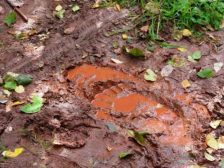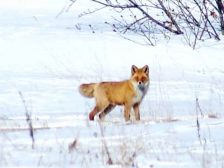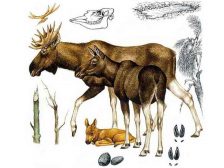Traces of animals
Hello dear readers of the portal Shootinfo.com. Each hunter must identify the traces of the animals and to develop the further strategy of the hunt accordingly. Every hunter is a strategist, yes, a strategist in the full sense of the word, and without some specific information there can be no strategy. Therefore, it can be said, no serious hunt will take place. At first it is necessary to understand what we mean under the traces of animals. Traces are different – information traces, traces of movement, traces of animals’ life-points, traces associated with the device of refuge, traces of feed activity. Let’s start the analysis:
a. Information traces are the allocation of musk glands, snacks or scratches on trees and on the ground, sound signals that indicate the occupation of the territory by an individual or group of animals.
b. Traces of movement are broken bushes, blockage from the movement of animals along the branches, prints of paws and other parts of the body on the grass, sand, mud,
feathers and other traces of the wings of birds.
c. Traces of life-points are traces of molting and courtship for feathers and hair, mud baths, traces of marriage tournaments, urinary points, dead bodies of dead animals and birds.
d. Traces of food activities are the traces of food search, debris and plant cracks, stocks and food residues, traces of hauling prey.
e. Traces associated with the device of refuge are the nests, lairs, burrows, passages under snow, animal beds.
 An important factor is the freshness of the traces. Remember that a fresh trace is left 10-15 minutes ago, the old trace – 5-10 hours ago, a very old trace – a day or more. And how can a hunter determine this? For this:
An important factor is the freshness of the traces. Remember that a fresh trace is left 10-15 minutes ago, the old trace – 5-10 hours ago, a very old trace – a day or more. And how can a hunter determine this? For this:
a. The hunter can try to traverse the trail with a branch; the branch will cut a fresh trail, the old track will also be cut, but the branch will bend, the old track cannot be cut, but it will turn out from under it.
b. When the frost is from -150 to 200С the urine of the animals retains the natural color on the snow for 1.5 hours, and then begins to darken. Then, wet with urine the snow falls into small pieces within an hour and then freezes after 3-4 hours. The litter remains soft up to an hour. After 1-2 hours the surface freezes, and after 3 hours it freezes through.
c. The hunter can try to touch the traces – at the frost on the dry snow the fresh trace is soft and the older, the harder it is. At a frost of -100С the trace slightly hardens in 15-20 minutes, and at -150 -200С it hardens in 5 minutes. In the case of small animals such as mice, ermine, the print s do not harden with surface traces, therefore it is impossible to determine their prescription by touch. In case of big animals, the traces are deep and the crust appears very quickly.
s do not harden with surface traces, therefore it is impossible to determine their prescription by touch. In case of big animals, the traces are deep and the crust appears very quickly.
d. In frost, you can slip your hand under the trace and lift it. A fresh trace in this case will crumble, the older one will remain in the hand in the form of a lump of snow, the greater the thickness, the older the trace.
e. On a deep snow the fresh trace looks gently in sunny weather. If the release of snow is delicate, like a snow frost, you can see dashes from claws and hoof tips, which means that the beast has just been here.
Best regards shootinfo.com.
















